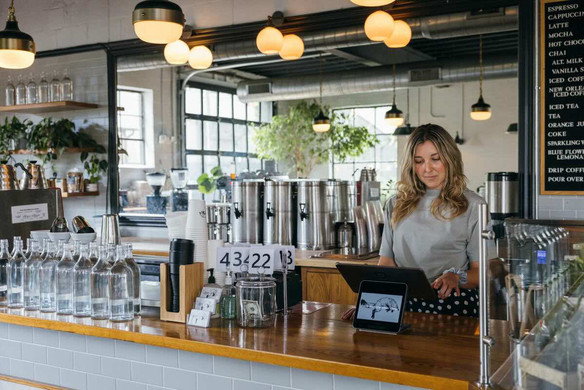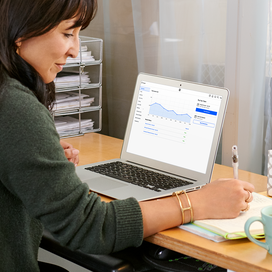Table of contents
Multihyphenates — restaurant and retail businesses that sell noncore offerings, subscriptions, or other services — are booming. According to Square data, 90% of surveyed restaurant business owners plan to start up new revenue streams over the next year. The multihyphenate business model is growing for good reason: According to the 2024 Future of Multihyphenates report, for 48% of restaurateurs, 11–20% of their business’s revenue comes from outside of their core restaurant service, including through retail items, classes, events, and more.
Adding a coffee arm to an existing business is one route business owners are taking to pursue the multihyphenate business approach. Take Salon Mane and Company, which recently opened their next-door coffee shop, Kiki’s Coffee, for salon guests and walk-ins to enjoy.
If you’re considering something similar and thinking about adding a coffee shop to your business, it could pay off. In 2022 the coffee shop industry in the United States alone was worth more than $45 billion. But every business owner knows that getting started isn’t as simple as it sounds. Without understanding all the costs involved, you risk spending more than what you plan to earn through an additional revenue stream. Read on to understand all the costs associated with adding a coffee shop to your current business so you can make your expansion plans a success.
Getting started: Initial costs for adding a coffee shop to your business
When you already have a business with a storefront, it can be relatively affordable to add new services at your current location, compared to opening something brand new. Some costs, however, like new mandatory permits and licenses, may surprise you. Here’s a snapshot of what to expect when you get started.
Real estate and location
For new, stand-alone coffee shops and restaurants, real estate is often the second-most significant cost, falling just behind food and labor costs. Investopedia cites that according to the National Restaurant Association, rent and utilities for restaurants account for an average of 29% of every dollar in sales. By operating from an existing establishment, however, you may be able to add a coffee shop and bakery counter without any additional real-estate costs. Ensure that your landlord or lease permits the new business line before you start construction or move in new counters. If an adjacent space is unoccupied, you may be able to work out a deal to expand. Plan on a similar cost per square foot to expand your business footprint.
Licenses and permits
Depending on your location, you may need additional licenses and permits to operate a food-and-beverage business. If you already have a retail store, you don’t necessarily need to register with your secretary of state or create a new entity. However, you still need to comply with local and state laws. For businesses in Texas, for example, the Texas Department of Health and Human Services requires retail food sellers to obtain a permit that costs $258–$773 per year, based on annual sales volumes. Some cities and counties may require additional licenses or permits. Check with your local city and county governments for detailed rules. Your state’s department of revenue and local health department are good places to start.
Equipment and inventory
Coffee-making equipment for a full-service coffee shop is more costly than the coffee machine you may have at home. The coffee equipment you pick influences what you can make, how fast you can whip up a specialty drink, and beverage quality. Certain well-known brands also command a premium price. For equipment only, budget $1,500–$30,000 for espresso makers and other coffee gear. If you offer baked goods, you may also want a small commercial oven, which can cost around $200–$1,000 or more. For cleaning, you’ll want a three-compartment sink. Small, concession-sized sinks start around $100. Commercial cafe counters start at around $500, though you may be able to get by with something cheaper from a local furniture store. Fancier counters cost upwards of $2,000.
Your initial order for coffee, milk, creamer, flavors, and other ingredients varies widely by brand and source. Generally you’ll find a better price per unit when buying from a wholesale distributor. Other consumables include disposable cups, lids, stirrers, paper sleeves, drink carriers, and cleaning supplies. More on these costs, which also double as ongoing expenses, are below.
Operating costs: Ongoing costs for supplies, staff, and more
Once you’re up and running, you should track additional costs to maintain a healthy profit margin. The main areas to focus on include staffing and inventory, which are part of your business’s total prime costs. “A good rule is to try to keep your prime costs at under 65 percent,” says Ming-Tai Huh, head of restaurants at Square.
Ingredients and inventory
For drip coffee wholesale pricing is about $7–$22 per pound, with higher pricing for specialty blends from craft roasters. That translates to around $0.33–$0.66 per cup. Disposable cups from certain suppliers can start at a little under $0.03 each, while a set including lids and paper sleeves starts at $0.20. Not including ingredients, supplies cost $500–$1,000 per month, including cleaning supplies, napkins, and disposable cups.
Utilities and maintenance
By adding an existing business in the same space, you’ll likely see a slight uptick in electricity usage for making beverages and running the coffee station, as well as more water usage to make the coffee and extra bathroom visits for guests. Considering your existing utilities, the additional costs here should be negligible. You’ll have a little more wear and tear on your facilities with more foot traffic, so maintenance costs may also increase modestly.
Staff salaries and benefits
According to Bureau of Labor Statistics (BLS) data, food service workers earn an average of $12–$17 per hour, though some local governments enforce higher minimum wages. In addition to wages you’ll have to pay taxes, insurance, and benefits. The Square Payroll Index helps employers understand typical staffing costs by location. We found the median hourly earnings for restaurant workers to be $17.67 nationwide, while the top 10% earn $28.10 per hour.
All-in, taxes and benefits typically add 25%–40% of the worker’s salary, leading to an effective hourly cost of $15–$24. If you already have hourly staff, look at the average cost per employee and assume a similar rate for the coffee counter.
Marketing and branding
If you already have a healthy marketing strategy, you may be able to tack on the coffee shop without spending much more. A typical, stand-alone coffee shop business spends around $1,000–$3,000 for marketing and publicity at launch. Depending on your needs, you can allocate a portion of your existing marketing budget to the new venture. Consider casting a wide net, including social media, flyers, and partnerships with local nonprofits, among other advertising strategies. Reaching the largest relevant audience can help you build brand loyalty and recognition.
Software systems
If you are venturing into new food-and-beverage service areas, you may need to reevaluate your tech stack to support new needs. Adding Square for Restaurants to your business, for example, offers your team additional POS capabilities, such as menu, kitchen, and table management, as well as online menus for pickup or delivery. Depending on the pricing plan you choose, you can start using Square for Restaurants for $0 a month plus processing fees.
Square for Restaurants connects seamlessly to other ecosystem solutions, such as Square Payroll, and Square payment processing can help you handle employee compensation needs and process sales easily. Connected technology can help your team keep costs low with automation. “A customer comes in, takes their order at the Square POS terminal. It’ll shoot the order back to our Square Kitchen Display System when the order is ready, and it will text the customer using the Square Text Messaging feature. So really, Square is keeping the lights on,” said restaurant owner Noah Holton-Raphael.
The owner of California-based Red Bay Coffee recently shared that adding automation helps staff serve more customers while maintaining quality. “It gives them an assistant,” Keba Konte said of automation’s ability to aid his staff. “It helps them do their job better, and it feels like they get some backup.” Automation also supports adding a new product line to a busy business.
Get started
Looking for more ideas on how to expand your business? Get your free copy of the 2024 Future of Multihyphenate Businesses report to get insight into how successful business owners are introducing new offerings to their restaurants, stores, salons, and more.
Brewing success with cost management fundamentals
While it’s critical to know the costs involved in adding a coffee shop to your existing business, continuing to monitor them and your overall business performance is critical for long-term success. By using information from Square Dashboard, you can tap into real-time tracking and financial management in your coffee venture. It provides insights into daily sales, inventory levels, and transaction trends, helping you make informed decisions for the future.
Turning your company into a multihyphenate business offers unique opportunities to expand without the extensive costs of opening a new location. If you’re looking to estimate and manage costs for a coffee shop, check out our free restaurant profitability calculator, designed to help you optimize expenses and maximize profits for every sale.
![]()













